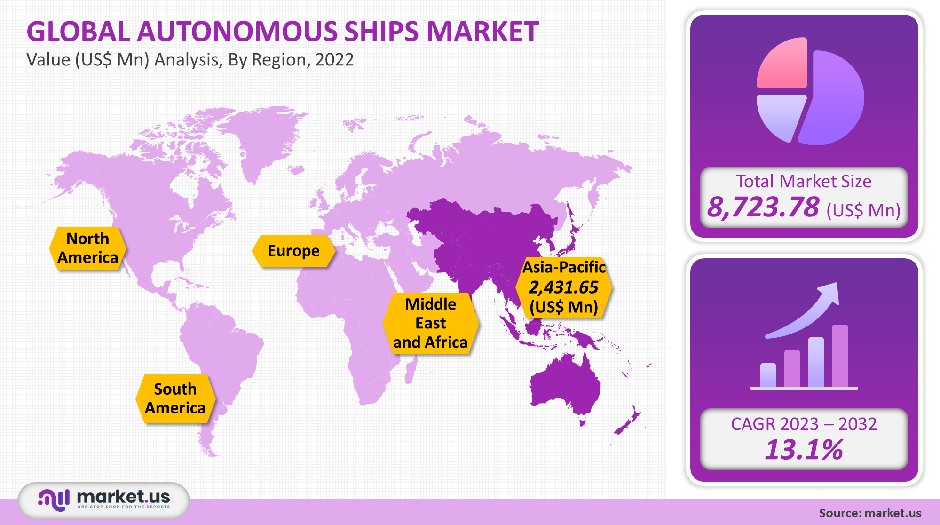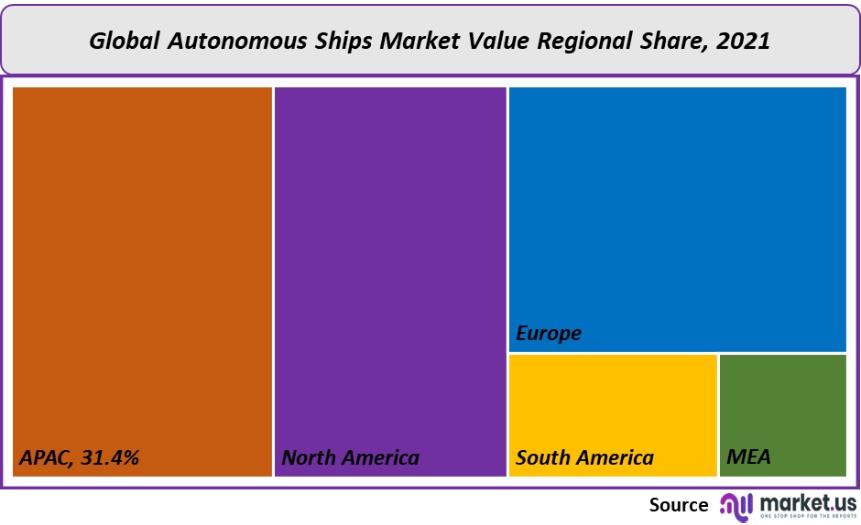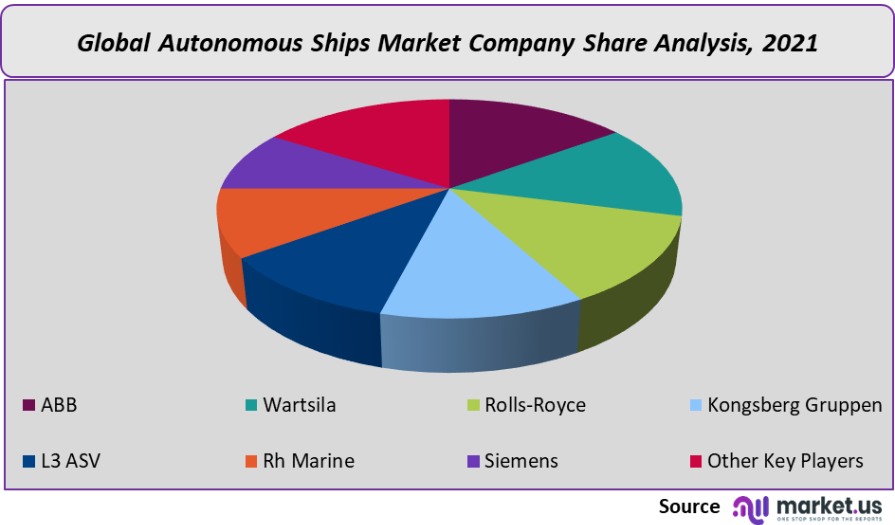Global Autonomous Ships Market By Autonomy Level (Semi-autonomous and Fully Autonomous), By Solutions (Systems & Software and Structure), By End-use (Commercial and Defense), By Region and Companies - Industry Segment Outlook, Market Assessment, Competition Scenario, Trends and Forecast 2022-2032
- Published date: May 2022
- Report ID: 12641
- Number of Pages: 377
- Format:
- keyboard_arrow_up
Autonomous Ships Market Overview:
The global market for autonomous ships was worth USD 8,723.78 million in 2021, and it is projected to grow at a CAGR of 13.1% over the forecast period.
Global Autonomous Ships Market
Autonomy Level Analysis
Based on the autonomous level, the market for autonomous ships can be divided into fully and semi-autonomous. Semi-autonomous vessels are expected to become commercially viable by 2021. However, semi-autonomous ship sales have driven most of the market. These ships are equipped with pre-installed components and systems, including sensors and navigation systems. These systems can be used on older vessels that are still in manual operation.
Fully autonomous ships will have a larger market share than semi-autonomous vessels by 2032. These benefits include the reduction of risk in transport, human error reduction, and efficient use of ship space.
Advanced navigation and maneuvering systems that make use of GPS and sensors could enable efficient ship transportation, without human intervention. The segment is expected to grow due to the lower operating costs and quicker operations of fully autonomous vessels.

Solutions Analysis
The solutions market has been divided into two segments: software and structures, and systems and software. Due to increasing automation in existing vessels, the market share for systems and software was dominant in 2021.
For automating one or more ship processes, sensors, including autonomous navigation systems like Collision Avoidance (CA), Dynamic Positioning(DP), Route Planning (RP), and Situational Awareness (SA), are being installed in newly built vessels. This is expected to be good for the segment’s growth.
Fully automated ship structures remain in R&D before the actual commercial operation, which is expected by 2032. The autonomous ship structures will see the greatest growth in the forecast period. These structures will be equipped with in-built autonomous systems which can be added during shipbuilding.
Because they don’t require sailors to navigate, fully autonomous ship structures can carry more cargo. In the future, the segment will see growth due to increased cargo space combined with the elimination of crew. This will result in a reduction in personnel and auxiliary costs for onboard provisions.
End-Use Analysis
The market was dominated by the commercial segment in 2021. These systems are expected to increase the growth of the segment by reducing operating costs and providing more cargo space.
While unmanned ships are designed and planned to operate without any human intervention or minimal human intervention, they could cause irreparable damage.
These systems pose a risk to hackers, terrorists, and criminals. Because these ships rely on the electromagnetic spectrum, along with cyberspace infrastructure and human responders, adversaries could have the opportunity to interfere with them and use them as weapons. Therefore, deployments of fully-autonomous vessels in the defense sector are expected to slow down over the forecast period.
Key Market Segments
Autonomy Level
- Semi-autonomous
- Fully Autonomous
Solutions
- Systems & Software
- Structure
End-use
- Commercial
- Defense
Market Dynamics
Growth is expected to be driven by increasing seaborne trade around the world and growing maritime tourism. The lack of skilled sailors will drive automation. These systems are used to automate multiple processes such as navigation, propulsion, and other functions.
Many of these systems can be found in various industries and are being used for different purposes, such as automotive and aerospace. To ensure the reliability and economic efficiency of unmanned vessels, the maritime industry has made huge financial investments.
Over the years, cargo shipping has seen a dramatic rise and commercial ships have been able to capitalize on this trend. These ships are used to transport various goods to distant locations.
A rise in a marine accident caused by human error leads to financial losses and damage to the marine ecosystem. According to the International Tanker Owners Pollution Federation (ITPF), there were three major spillages of more than 700 tones of oil and three smaller spillages ranging from 7 to 700 tones.
In order to reduce the impact of such accidents on the environment, governments around the world have put in place strict regulations. Expect autonomous vessels to provide benefits such as fewer accidental cases, or even no human involvement in the fleet. This will positively impact market growth.
Also, maritime trade is on the rise worldwide. This requires more ships to transport freight. This would require large numbers of seafarers to transport the freight. Seagoing careers have seen a decline due to the low-paying nature of the work. The millennials are also restricted by the isolation that comes with such jobs.
This has led to a decrease in seafarers and a rise in unmanned ships. Unmanned ships on the one hand reduce the labor-intensive ship operation, which in turn lowers the pressure on seafarers’ labor markets. The downside is that most onboard tasks could be automated. This would mean that manual tasks such as navigation and technology would have to be done from the shoreside. This makes seafaring jobs more appealing and family-friendly.
The use of robotics and AI continues to grow. It is possible that the Internet of Things would soon integrate seamlessly into every sector and industry. Top maritime and IT industry giants such as ABB and Rolls-Royce founded the One Sea Ecosystem in 2016.
The One Sea -Autonomous Maritime Ecosystem has created a roadmap for a future in which ships are autonomous. It contains information on autonomy levels as well as a 2025 timetable. It primarily focuses on preventing accidents, lowering maritime traffic’s environmental footprint, and increasing the efficiency of autonomous marine initiatives. The demand for unmanned vessels is projected to rise as more attempts are made to develop an autonomous marine environment.
Regional Analysis
The Asia Pacific dominated the market with a 31.4% revenue share. One of the most important shipping nations in the world is responsible for the higher market share. China is a strong market player with the most container and bulk port networks. China’s maritime trade accounts for over 60% of its total trade. This is expected to boost the demand for commercial ships in the country and help to grow the market.
Europe is predicted to see the fastest CAGR in the forecast period due to the growing demand for autonomous and cruise ships.
Europe is home to the most ship-owners in all of the world. This is due to the increasing adoption of autonomous systems by ship owners and the retrofitting of components on existing ships. Over the forecast period, the region will experience rapid technological advancements and an increase in the adoption of automated systems.

Key Regions and Countries covered іn thе rероrt:
- North America
- US
- Canada
- Mexico
- Europe
- Germany
- UK
- France
- Italy
- Russia
- Spain
- Rest of Europe
- APAC
- China
- Japan
- South Korea
- India
- Rest of Asia-Pacific
- South America
- Brazil
- Argentina
- Rest of South America
- MEA
- GCC
- South Africa
- Israel
- Rest of MEA
Market Share Analysis
ABB and Rolls-Royce are the most prominent market players. These market leaders are focused on different business strategies in order to increase their market share. These market players use partnerships, mergers, and acquisitions as well as contractual agreements to increase their market share.
A number of large players are currently testing fully autonomous ships, which are expected to transform the entire shipping sector. Rolls-Royce and Mitsui O.S.K. were among the first to test autonomous vessels in December 2017.
Lines announced that they would enter into a partnership for joint research on an advisory type Intelligent Awareness System (IAS). This system detects obstacles near ships with advanced sensors and provides immediate operational support information for the onboard personnel.

Key Market Players
- ABB
- Wartsila
- Rolls-Royce
- Kongsberg Gruppen
- L3 ASV
- Rh Marine
- Siemens
- Other Key Players
For the Autonomous Ships Market research study, the following years have been considered to estimate the market size:
Attribute Report Details Historical Years
2016-2020
Base Year
2021
Estimated Year
2022
Short Term Projection Year
2028
Projected Year
2023
Long Term Projection Year
2032
Report Coverage
Competitive Landscape, Revenue analysis, Company Share Analysis, Manufacturers Analysis, Volume by Manufacturers, Key Segments, Key company analysis, Market Trends, Distribution Channel, Market Dynamics, COVID-19 Impact Analysis, strategy for existing players to grab maximum market share, and more.
Regional Scope
North America, Europe, Asia-Pacific, South America, Middle East & Africa
Country Scope
United States, Canada and Mexico, Germany, France, UK, Russia and Italy, China, Japan, Korea, India and Southeast Asia, Brazil, Argentina, Colombia etc.Saudi Arabia, UAE, Egypt, Nigeria and South Africa
Frequently Asked Questions (FAQ)
Q: What is the size of the Autonomous Ships market in 2021?A: The Autonomous Ships market size is estimated to be US$ 8,723.78 million in 2021.
Q: What is the projected CAGR at which the Autonomous Ships market is expected to grow at?A: The Autonomous Ships market is expected to grow at a CAGR of 13.1% (2023-2032).
Q: List the segments encompassed in this report on the Autonomous Ships market?A: Market.US has segmented the Autonomous Ships market by geographic (North America, Europe, APAC, South America, and Middle East and Africa). By Autonomy Level, market has been segmented into Semi-autonomous and Fully Autonomous. By Solutions, the market has been further divided into Systems & Software and Structure. By End-use, market has been segmented into Commercial and Defense.
Q: List the key industry players of the Autonomous Ships market?A: ABB, Wartsila, Rolls-Royce, Kongsberg Gruppen, L3 ASV, Rh Marine, Siemens, and Other Key Players engaged in the Autonomous Ships market.
Q: Which region is more appealing for vendors employed in the Autonomous Ships market?A: Asia Pacific is accounted for the highest revenue share of 31.4%. Therefore, the Autonomous Ships industry in Asia Pacific is expected to garner significant business opportunities over the forecast period.
Q: Name the key areas of business for Autonomous Ships?A: The U.S., Canada, U.K., Germany, France, China, India, Japan, Brazil, and Mexico are key areas of operation for Autonomous Ships Market.
Q: Which segment accounts for the greatest market share in the Autonomous Ships industry?A: With respect to the Autonomous Ships industry, vendors can expect to leverage greater prospective business opportunities through the Semi-autonomous segment, as this area of interest accounts for the largest market share.
![Autonomous Ships Market Autonomous Ships Market]()
- ABB Ltd Company Profile
- Wartsila
- Rolls-Royce
- Kongsberg Gruppen
- L3 ASV
- Rh Marine
- Siemens Aktiengesellschaft Company Profile
- Other Key Players
- settingsSettings
Our Clients
|
Single User
$5,999
$2,999
USD / per unit
save 50% |
Multi User
$7,999
$3,499
USD / per unit
save 55% |
Corporate User
$12,999
$4,499
USD / per unit
save 65% | |
|---|---|---|---|
| e-Access | |||
| Data Set (Excel) | |||
| Company Profile Library Access | |||
| Interactive Dashboard | |||
| Free Custumization | No | up to 10 hrs work | up to 30 hrs work |
| Accessibility | 1 User | 2-5 User | Unlimited |
| Analyst Support | up to 20 hrs | up to 40 hrs | up to 50 hrs |
| Benefit | Up to 20% off on next purchase | Up to 25% off on next purchase | Up to 30% off on next purchase |
| Buy Now ($ 2,999) | Buy Now ($ 3,499) | Buy Now ($ 4,499) |









